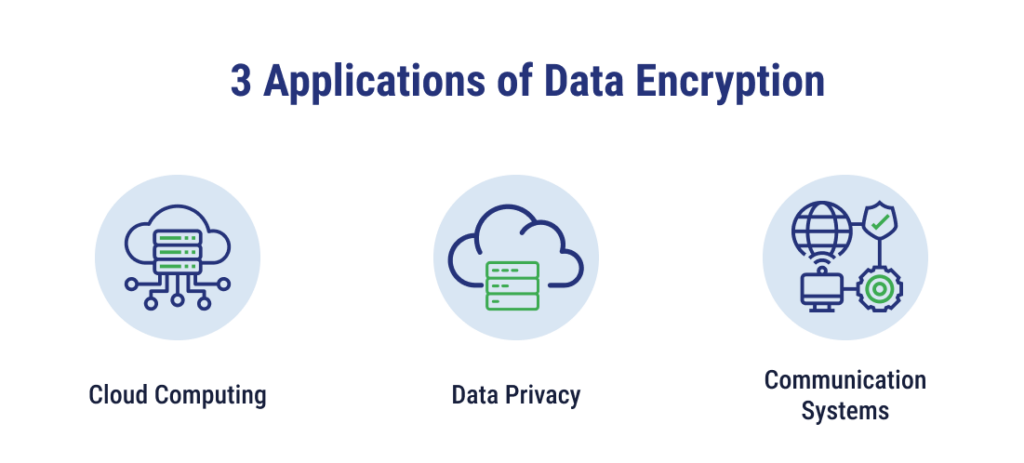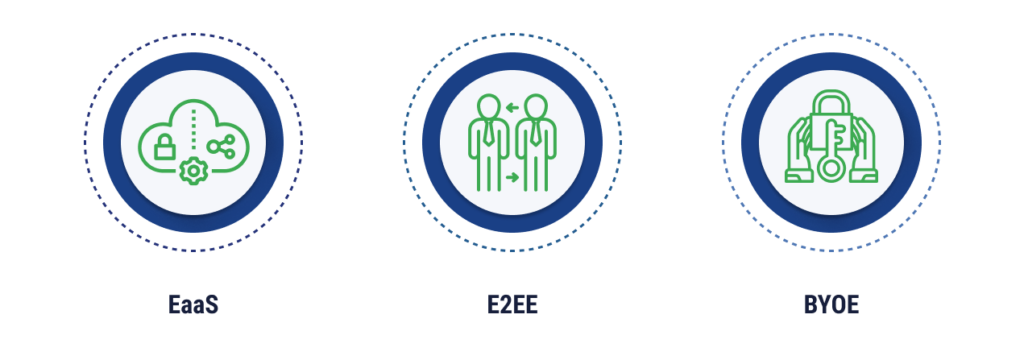
Cybercriminals are finding new ways every day to gain access to sensitive information to profit and gain power from the businesses they can exploit. Data breaches continue to be an expensive problem for businesses, and unencrypted data increases the risks associated with data breaches. One way businesses can reduce risks from several attack vectors, including stolen credentials and malicious insiders, is through data encryption.
What Is Data Encryption?
Data encryption is a process where readable data is turned into an unreadable format, from plaintext to ciphertext. This is done through an encryption algorithm that can only be reverted back by using the correct decryption key. Encrypting data greatly enhances data security and confidentiality, allowing authorized users to access information without worrying about outside parties intercepting anything useful. It can play a vital role in data loss prevention.
Understanding the Key Benefits of Data Encryption
Data encryption can help businesses share information securely, comply with relevant regulatory standards, and boost customer trust. Here are some key benefits to implementing data encryption:
- Enhanced Security: Data encryption can be an effective measure to protect sensitive information, including financial. This is done through an encryption algorithm that can only be turned off with an encryption key records, personal data, and intellectual property. Because the data is encrypted, even if someone were to gain access to it, they wouldn’t be able to understand it unless they had a decryption key.
- Greater Compliance: Industry regulations and other compliance standards require data to be encrypted. For example, HIPAA recommends encryption for data in transit and at rest.
- Data Integrity: Data can be secured even more when encryption is paired with a cryptographic hash function. These functions serve as a fingerprint for data and will change if the data is altered to denote tampering.
- Secure Communications: Without proper encryption, sending an email should be treated like sending a postcard – someone could intercept and read it. TLS protocols, like HTTPS, can protect data transmitted over the internet, ensuring that communication channels are more secure.
- Risk Reduction: When data is not readable or usable to bad actors, it becomes less valuable and less of a risk for an organization. For example, if an employee has their mobile device or work laptop stolen, the encrypted data on the device will remain protected.
- Customer Trust: Showing that you are taking steps toward protecting sensitive data can also instill greater trust in customers. They may be more likely to engage with businesses that they know handle their data more conscientiously.
Common Applications of Data Encryption
Organizations often use data encryption in cloud computing environments, in situations where data privacy is paramount, and when looking to bolster protection in communication systems.

Data Encryption in Cloud Computing
Cloud environments can store large amounts of sensitive data, making them an essential venue for data encryption. Data encryption in the cloud should include protection when it is stored on cloud servers, as well as when it is moving between users and cloud services. Cloud providers often offer encryption options, such as AWS Key Management Services and Azure Key Vault. Businesses can also bring their own tools to the cloud.
Data Encryption for Data Privacy
Data privacy is an issue in the cloud and elsewhere. Anywhere businesses are looking to safeguard personal and confidential data, encryption is necessary. This can include encrypting personal files on devices to reduce risks associated with theft, protecting financial data during online transactions, and encrypting patient data when exchanging information.
Data Encryption in Communication Systems
Online communications, including instant messaging, VoIP, and email, can be encrypted to improve the security of communication channels. This can be important when discussing sensitive matters. Measures organizations might take include using HTTPS protocols, using VPNs to encrypt internet traffic, and employing end-to-end encryption in instant messaging.
Implementing Data Encryption: Best Practices
It’s likely that not all data needs to be encrypted. By taking the following steps, your organization can protect your most critical data while cutting down on unnecessary measures.
- Identify Sensitive Data: Categorize and classify your organizational data to determine what is personal, financial, confidential, or intellectual property. These types of data will require additional protection. Understand what is being stored (at rest) and what is being transferred (in transit).
- Determine the Right Encryption Method: Once you know what data you want to encrypt, it’s time to choose an encryption method and algorithm. Your consideration may include how sensitive the data is, what performance requirements you have for the data after it’s been encrypted, and how compatible the encryption tool will be with your existing systems. This can include AES (Advanced Encryption Standard) for general encryption, RSA for public keys, and TLS or SSL for web traffic. You’ll also need to choose between asymmetric encryption and symmetric encryption. Asymmetric encryption uses a public key and a private key for additional security, but it is also a slower solution. Symmetric keys have a single key to encrypt and decrypt data, making it faster but easier to compromise.
- Choose an Effective Key Management Strategy: An encryption strategy isn’t worth anything without a key. Your organization will have to decide how keys are created, stored, shared, changed, and destroyed. A cloud-based service is one way to go if your workloads are hosted with a cloud provider, but there are other options for key management, such as implementing a hardware security module (HSM), a dedicated physical device used to securely manage encryption keys.
- Ensure Compliance and Regulatory Standards: Whichever tools and methods you choose, your approach will need to be compliant with the proper regulations, such as PCI DSS, HIPAA, and GDPR. Document your processes and make note of any changes to your processes along the way.
- Train and Educate Employees: Employees can be a source of great vulnerability for your business, especially if they aren’t trained in how to properly handle data and reduce their exposure to security risks. Invest time in comprehensive training depending on how you are choosing to encrypt and what role different employees will play.
- Perform Regular Security Audits: Finally, ensure that all processes and tools are up-to-date and working as intended by performing regular security audits. This can include vulnerability assessments, compliance checks, penetration testing, and reviews of key management. Consider adding some automated compliance tools to help with the review process.
What’s Next for Data Encryption Solutions?
As data encryption becomes more essential, expect to see a greater emphasis on encryption as a service (EaaS), end-to-end encryption, and bring your own encryption (BYOE) tools.

- Encryption as a Service (EaaS): IT teams can feel overwhelmed with their existing workload without having to worry about adding encryption to the mix. Small teams and busy organizations can benefit from encryption as a service (EaaS), an offering that allows businesses to hand key management, compliance, and algorithm selection to an expert provider. This provider can also assist with integration and implementation.
- End-to-End Encryption: End-to-end encryption (E2EE) ensures that the only parties that can access data are the sender and the recipient. Third-party interception, not even the service provider can access the encrypted data during transmission. This is a trend that’s becoming more common in services such as instant messaging, password management, email, and other communication platforms. As organizations seek out more zero-trust security models, we are likely to see more E2EE get rolled out.
- Bring Your Own Encryption: Businesses looking for the greatest level of control can benefit from bring your own encryption (BYOE). Organizations can bring their encryption keys and solutions to their environment of choice, including the cloud. This can allow for greater sovereignty in the cloud and is likely to become more common, especially for businesses in regulated industries looking for more secure options.
Protect Your Business and Safeguard Sensitive Data
Businesses face more incoming cyber threats than ever, some of which become more costly for businesses when data is easily accessible and shareable. Protecting sensitive data is not an optional activity, but an essential part of doing business in today’s digital world as part of taking a proactive security stance. If you are looking for ways to secure your data in transit and at rest, TierPoint’s data protection and security solutions can ensure you stay protected and available.

